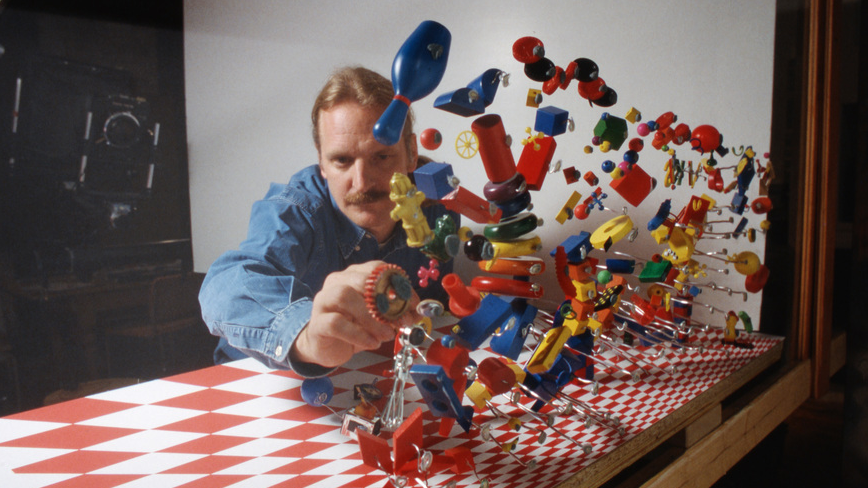- Since 1992, the “I Spy” riddle-book series has captured the imagination of millions of readers.
- Part of what made these books so magical is that all of the images were created with real objects.
- Photographer Walter Wick carefully arranged each scene and hid the objects. Then author Jean Marzollo wrote the rhymes.
- Walter’s newest book, “A Ray of Light”, uses beautiful photographs to teach kids about the principals of light.
- Visit Business Insider’s homepage for more stories.
Following is a transcript of the video.
Narrator: Can you find the seal on the ball? It’s hiding behind those blocks. What about the rubber band? That’s over by the alligator. Does this look familiar? These photos are from the “I Spy” book series, introduced in 1992, and there’s a good chance that either you or your kids have read them. But did you know that all of these images were created with real objects? The magic and mystery within these books is directly tied to the imagination of the photographer behind them, Walter Wick.
Walter Wick: My name is Walter Wick. I am a photo-illustrator, and I’ve been doing that for I don’t know how long, since 1991.
Narrator: Before “I Spy,” Walter was a commercial photographer in New York City. One of his clients was Games magazine, which created puzzles and activities for each issue. But how did Walter end up working on “I Spy”? One day around 1980, Walter was cleaning up his studio and he decided to take a picture of the stray nuts and bolts he had lying around. Walter used that photo to promote his work, which is how the author Jean Marzollo saw it.
Walter: I got a call from Jean Marzollo to do a poster for her magazine, which is called Let's Find Out. It's a kindergarten magazine.
Narrator: An editor at Scholastic Books saw that poster and asked if Jean and Walter wanted to make a search-and-find children's book. Jean would write the rhymes, and Walter would create the images.
Walter: And I said sure, and that's how it started.
Narrator: But perhaps what made the books so successful was how realistic they looked. The combination of props, sets, and lighting created an immersive scene. Originally, Walter used a large-format camera to photograph each scene. This created huge 8-by-10 negatives. Which was ideal, because the larger image size captured a ton of detail. Then around 2004, Walter switched to digital. He now uses a Canon 5D. But Walter was quick to point out that the camera does little of the real work. Because it just sits there while Walter spends weeks building the sets.
Walter's studio is filled with the props and materials he uses to build these incredible images, like blocks, buttons, toys, and even pine cones.
Walter: I would hide the objects as I would build the shot. I wouldn't really think about hiding the objects first. I would create the shot, make a list of the hidden objects, send it to Jean, and then she would write the rhyme.
Narrator: Each scene is arranged very carefully around a central idea or theme, like nature, antiques, or school.
Walter: One of the problems with photo illustrations is you're limited by what you have available. The higher-level concepts became harder and harder and harder to do, though, as I went on, because I didn't want to repeat myself.
Narrator: But "I Spy" isn't the only series Walter has worked on. He's also the author and photo-illustrator of the "Can You See What I See?" books and "Hey, Seymour!" Which follow the search-and-find style of "I Spy."
In order to make these scenes a reality, Walter works with assistants, fabricators, and model-makers. For "Can You See What I See?: Toyland Express," Walter's team built a toy train from scratch because they needed to show it being assembled throughout the story. Each photo can take anywhere from a couple days to several weeks to create. The attention to detail is part of what makes these photos so compelling.
And Walter continues to capture the imagination of readers today. His newest book, "A Ray of Light," is a science book that uses beautiful photos to illustrate the properties of light. It's a companion to Walter's 1997 book "A Drop of Water."
Walter: I've always wanted to do the book on light. I was a little afraid of it. Because as much as I work with light and I know light, I was a little afraid to try and to explain the inner workings of it to young readers. But I finally did that.
Narrator: The "I Spy" and "Can You See What I See?" books have over 45 million copies in print. The care and attention to detail put into every frame still resonates with readers today.
Walter: I was very surprised from the very beginning how intensely kids looked at my photographs, so I just put that same intensity back into making them.
Narrator: Imagination and the sense of discovery are timeless.

